The Mississippian is a subperiod in the geologic timescale or a subsystem of the geologic record. It is the earlier of two subperiods of the Carboniferous period lasting from roughly 358.9 to 323.2 million years ago. As with most other geochronologic units, the rock beds that define the Mississippian are well identified, but the exact start and end dates are uncertain by a few million years. The Mississippian is so named because rocks with this age are exposed in the Mississippi Valley.
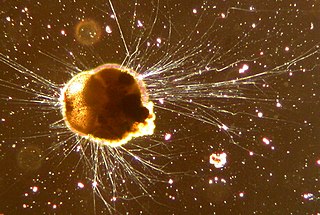
Foraminifera are single-celled organisms, members of a phylum or class of Rhizarian protists characterized by streaming granular ectoplasm for catching food and other uses; and commonly an external shell of diverse forms and materials. Tests of chitin are believed to be the most primitive type. Most foraminifera are marine, the majority of which live on or within the seafloor sediment, while a smaller number float in the water column at various depths, which belong to the suborder Globigerinina. Fewer are known from freshwater or brackish conditions, and some very few (nonaquatic) soil species have been identified through molecular analysis of small subunit ribosomal DNA.

Lobosa is a taxonomic group of amoebae in the phylum Amoebozoa. Most lobosans possess broad, bluntly rounded pseudopods, although one genus in the group, the recently discovered Sapocribrum, has slender and threadlike (filose) pseudopodia. In current classification schemes, Lobosa is a subphylum, composed mainly of amoebae that have lobose pseudopods but lack cilia or flagella.
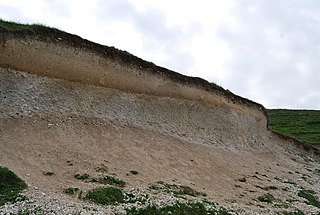
Calcareous is an adjective meaning "mostly or partly composed of calcium carbonate", in other words, containing lime or being chalky. The term is used in a wide variety of scientific disciplines.

The Fusulinida is an extinct order within the Foraminifera in which the tests are traditionally considered to have been composed of microgranular calcite. Like all forams, they were single-celled organisms. In advanced forms the test wall was differentiated into two or more layers. Loeblich and Tappan, 1988, gives a range from the Lower Silurian to the Upper Permian, with the fusulinid foraminifera going extinct with the Permian–Triassic extinction event. While the latter is true, a more supported projected timespan is from the Mid-Carboniferous period.
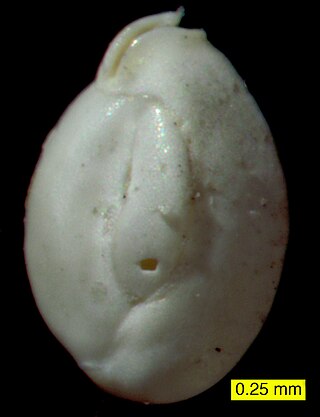
The Miliolida are an order of foraminifera with calcareous, porcelacous tests that are imperforate and commonly have a pseudochitinous lining. Tests are composed of randomly oriented calcite needles that have a high proportion of magnesium along with organic material. Tests lack pores and generally have multiple chambers.

Retaria is a clade within the supergroup Rhizaria containing the Foraminifera and the Radiolaria. In 2019, the Retaria were recognized as a basal Rhizaria group, as sister of the Cercozoa.

Quinqueloculina is a genus of foraminifera in the family Miliolidae.

Carterinida is an order of multi-chambered foraminifera within the Globothalamea. Members of this order form hard tests out of thin calcite rods known as spicules, which are held together by a proteinaceous matrix. As of August 2023, the order contains a single family, Carterinidae.
Hedbergella is an extinct genus of planktonic foraminifera from the Cretaceous, described by Loeblich and Tappan, 1961, as:
Test free, trochospiral, biconvex, umbilicate, periphery rounded with no indication of keel or poreless margin; chambers globular to ovate; sutures depressed, radial, straight or curved; wall calcareous, finely perforate, radial in structure, surface smooth to hispid or rugose; aperture an interiomarginal, extraumbilical-umbilical arch commonly bordered above by a narrow lip or spatulate flap, ... Includes species otherwise similar to Praeglobotruncana but which lack a keel or poreless margin, hence is regarded as a separate genus rather than as a subgenus of Praeglobotruncana as by Banner and Blow (1959).

Helen Niña Tappan Loeblich was an American micropaleontologist who was a professor of geology at the University of California, Los Angeles, a United States Geological Survey (USGS) biostratigrapher, and a scientific illustrator whose micropaleontology specialty was research on Cretaceous foraminifera.
Alfred R. Loeblich Jr (1914–1994) was an American micropaleontologist. He was married to Helen Niña Tappan Loeblich and the two co-authored a number of important works on the Foraminifera and related organisms.

Tubothalamea is a taxonomic class established for foraminiferans with tubular chambers. Includes the porcelaceous and agglutinated Miliolida and the monocrystalline and agglutinated Spirillinida. It is one of two classes of multichambered foraminifera based on SSU rDNA molecular studies with consideration of major morphological trands, the other being the Globothalamea.

Globothalamea comprises a class of multichambered foraminifera based in part on SSU rDNA evidence; the other is Tubothalamea.

Cyclammina is a genus of foraminifers in the family Cyclamminidae. Most species are extinct, but there are a few that are extant.

Cuneolina is an extinct genus of prehistoric foraminifera in the family Cuneolinidae with species from the Jurassic and Cretaceous.
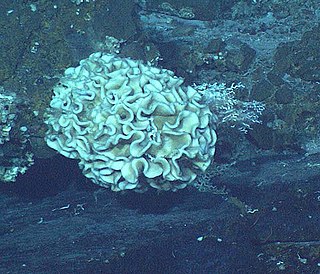
"Monothalamea" is a grouping of foraminiferans, traditionally consisting of all foraminifera with single-chambered tests. Recent work has shown that the grouping is paraphyletic, and as such does not constitute a natural group; nonetheless, the name "monothalamea" continues to be used by foraminifera workers out of convenience.
Earlandia was a genus of prehistoric foraminifera.
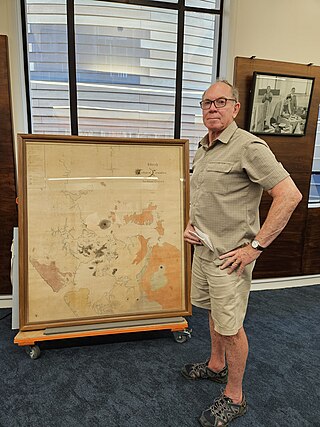
Bruce William Hayward is a New Zealand geologist, marine ecologist, and author. He is known as a leading expert on living and fossil foraminifera.
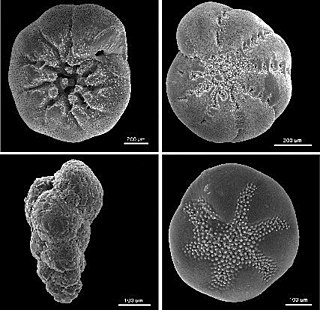
Foraminiferal tests are the tests of Foraminifera.














